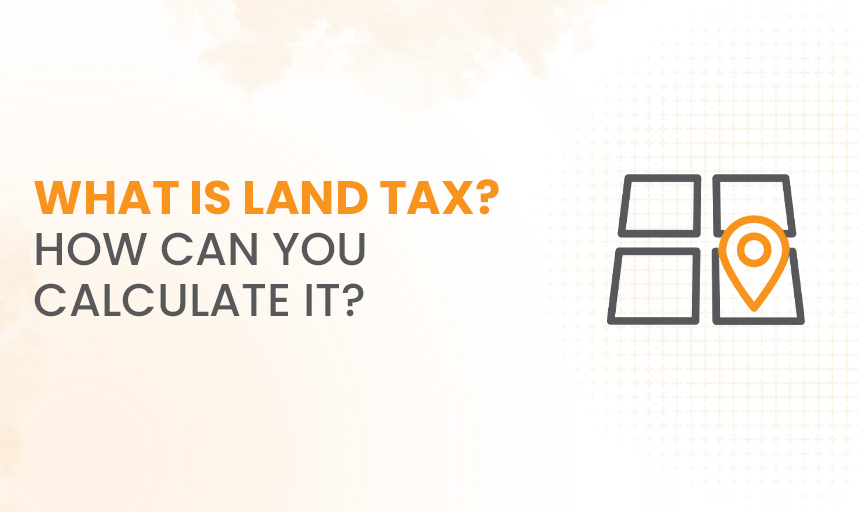What is Land Tax? How Can You Calculate it?

Have you ever wondered why property owners have to pay a certain tax each year based on the value of their land?
It’s a question many property owners grapple with, yet understanding the ins and outs of this tax is crucial for anyone involved in real estate.
This tax known as Land Tax, plays a vital role in funding essential public services. But what exactly is this tax?
So we decided to break through the mysteries around this and help you understand Land tax and how you can calculate your potential liability and understand the system effectively.
What is Land Tax?
Land tax is an annual state government levy imposed on the site value of land you own at midnight on June 30th each year. It contributes towards essential government services like healthcare, education, and public safety.
Who is Liable for Land Tax?
The owner of the property as of June 30th is liable to pay land tax for the following financial year. There are a few exceptions, which we’ll explore later.
Land Tax Rates and Thresholds
General Rates Table
This table outlines the general land tax rates applicable to most landowners in Australia. However, it’s crucial to refer to your specific state revenue office website for the latest and most accurate rates, as they may vary slightly.
| Total Taxable Site Value | Amount of Tax |
| Does not exceed $668,000 | Nil |
| Exceeds $668,000 but not exceeding $1,073,000 | $0.50 for every $100 or part thereof exceeding $668,000 |
| Exceeds $1,073,000 but not exceeding $1,561,000 | $2,025 + $1.00 for every $100 or part thereof exceeding $1,073,000 |
| Exceeds $1,561,000 but not exceeding $2,500,000 | $6,905 + $2.00 for every $100 or part thereof exceeding $1,561,000 |
| Exceeds $2,500,000 | $25,685 + $2.40 for every $100 or part thereof exceeding $2,500,000 |
Trust Rates Table
Land owned by trusts is subject to different tax rates and thresholds compared to general rates. The table below provides a general guideline, but always refer to your state revenue office for the most current information.
| Total Taxable Site Value | Amount of Tax |
| Does not exceed $25,000 | Nil |
| Exceeds $25,000 but not exceeding $668,000 | $125 + $0.50 for every $100 or part thereof exceeding $25,000 |
| Exceeds $668,000 but not exceeding $1,073,000 | $3,340 + $1.00 for every $100 or part thereof exceeding $668,000 |
| Exceeds $1,073,000 but not exceeding $1,561,000 | $7,390 + $1.50 for every $100 or part thereof exceeding $1,073,000 |
| Exceeds $1,561,000 but not exceeding $2,500,000 | $14,710 + $2.40 for every $100 or part thereof exceeding $1,561,000 |
| Exceeds $2,500,000 | $37,246 + $2.40 for every $100 or part thereof exceeding $2,500,000 |
How is Land Tax Calculated?
Land tax is calculated based on three key factors:
- Site Value: This is the market value of your land, excluding any buildings or structures on it. The Valuer-General determines the site value annually.
- Land Use: The purpose for which you use your land (residential, commercial, industrial, etc.) can influence the tax rate.
- Ownership: How you own the land (sole ownership, joint ownership, trust ownership) affects the assessment process.
Here’s a simplified breakdown of the calculation process:
- 1: Aggregate Site Value: If you own multiple parcels of land, their individual site values are combined to form a total taxable site value.
- 2: Apply Land Tax Rates: Land tax rates vary depending on the total taxable site value and whether the land is trust-owned or not. You can find the current land tax rates and thresholds on your state’s revenue office website.
- 3: Apportionment (For Multiple Properties): If you own multiple taxable properties within the same ownership, the total land tax is apportioned (divided) amongst them based on their individual site values.
Example
Let’s say Dave owns two vacant blocks of land:
- Block A: Site value – $400,000
- Block B: Site value – $600,000
Total taxable site value = $400,000 + $600,000 = $1,000,000
Assuming Dave resides in a state with the following general land tax rates (refer to your specific state for accurate rates):
- Up to $668,000: Nil tax
- Over $668,000 but not exceeding $1,073,000: $0.50 per every $100 or part thereof exceeding $668,000
Following the steps above:
- Total taxable site value = $1,000,000
- Land tax = $0.50 for every $100 or part thereof exceeding $668,000
- Land tax = $0.50 x ($1,000,000 – $668,000) = $165.00
- Since Dave owns just one ownership with two properties, no apportionment is needed. Her total land tax liability for the year is $165.00.
Land Tax Exemptions and Relief
Several exemptions and relief measures can help reduce your land tax liability or eliminate it entirely in some cases. Eligibility criteria vary depending on your state and the specific exemption.
Here are some common examples:
Principal Place of Residence (PPR)
Most states offer a full or partial exemption for the land you occupy as your principal place of residence (PPR). This exemption typically applies to one property per owner.
Here’s a further breakdown of PPR exemptions:
Variations by State
- New South Wales and Victoria offer a complete PPR exemption.
- Queensland provides a partial exemption based on a land value threshold.
- Other states may have different rules. Be sure to check your state revenue office website for details.
Eligibility Criteria
- The property must be your primary place of residence.
- You may need to be an Australian citizen or permanent resident.
- There may be ownership structure requirements (e.g., sole owner, joint ownership with a spouse).
Land Owned by Pensioners or Veterans
Some states offer concessions or rebates for land tax paid by pensioners, veterans, or seniors who meet specific income and asset criteria. Consult your state revenue office for details:
Examples of Concession Types
- Reduced tax rates
- Increased land value thresholds for exemption
- Deferral of land tax payments (paying at a later date)
Charities and Non-Profit Organisations
Registered charities and non-profit organisations may be eligible for full or partial land tax exemptions on land used exclusively for charitable purposes. The specific requirements will vary by state.
Other Potential Exemptions
- Vacant Land Held for Future Development: Some states offer relief for vacant land zoned for future development.
- Primary Production Land (PPL): Land used for agricultural, pastoral, or other primary production purposes may qualify for exemptions or concessions.
- Build-to-Rent Developments: Some states provide incentives for large-scale build-to-rent developments in the form of land tax exemptions.
How Can Professional Tax Experts Help To Tackle Land Tax?
Understanding land tax and handling the assessment process is essential for Australian landowners. But if you require expert guidance on calculating your land tax liability, you can contact KPG Taxation.
Their experienced tax consultants can help ensure you’re compliant and minimise your tax burden.
- Categories
- Land Tax

Focus On Growing Your Business, Leave The Accounting On Us!
- Income Tax : File your taxes & get the best claims & returns.
- Accountancy : Hire expert accountants to manage your transactions.
- Bookkeeping : Let us handle your record books and expense reports.
- Business Advisory : From company set-up to payroll, we handle it all.



